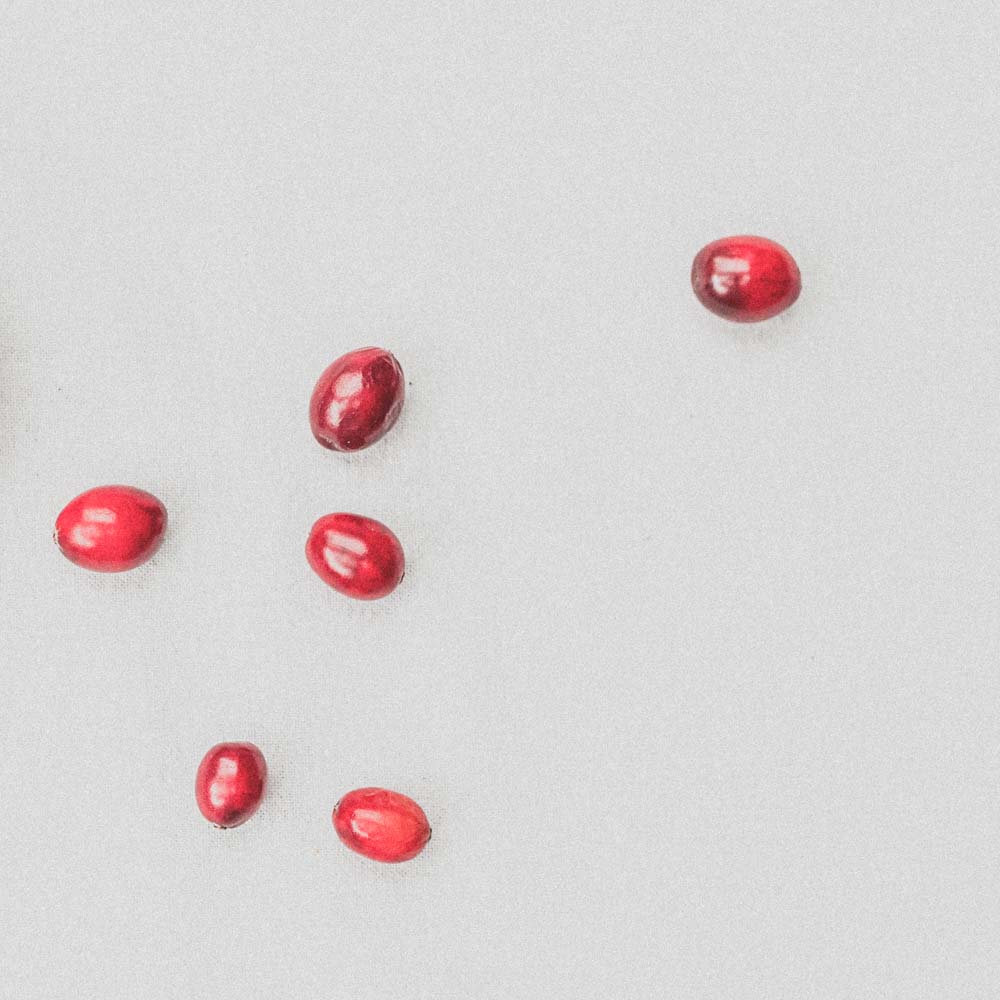Cranberry Seed Oil
INCI: Vaccinium Macrocarpon Seed Oil

Are you looking for a natural ingredient to add to your skincare routine? Look no further than cranberry seed oil. This oil has been gaining popularity in recent years due to its many skincare benefits. In this article, we will discuss what cranberry seed oil is, its history of use, and how it can benefit your skin.
Scroll down to read
What is Cranberry Seed Oil?
Cranberry seed oil is extracted from the seeds of the cranberry fruit. The oil has a light, golden color and is rich in essential fatty acids, antioxidants, and other beneficial compounds. It has a unique balance of omega-3, -6, and -9 fatty acids, making it an ideal ingredient for skincare products.
Skin Feel of Cranberry Seed Oil
Cranberry seed oil has a silky texture and a smooth, velvety feel that makes it easily absorbed by the skin without leaving any residue. This is due to its low comedogenic rating, fatty acid profile, and antioxidant content. These properties make it an excellent ingredient for use in skincare products that provide hydration and nourishment without feeling heavy or greasy.
Comedogenic Rating of Cranberry Seed Oil
Cranberry seed oil has a comedogenic rating of 0-1, which means that it is considered non-comedogenic or very low in its ability to block pores. This makes cranberry seed oil an excellent choice for use in skincare products for those with oily or acne-prone skin.
How Has Cranberry Seed Oil Been Used in the Past?
Cranberries have a long history of use in traditional medicine, dating back to Native American tribes who used the fruit to treat various ailments. Cranberries were used to make poultices, teas, and other remedies for conditions such as urinary tract infections, digestive issues, and wounds. The berries were also used as a source of food and were believed to have medicinal properties that could boost overall health.
In the modern skincare industry, cranberry seed oil has gained popularity due to its high levels of essential fatty acids, antioxidants, and other beneficial compounds. These properties make it an excellent ingredient for moisturizing and protecting the skin, reducing the appearance of fine lines and wrinkles, and improving overall skin health.
Benefits of Cranberry Seed Oil in Skincare
1. Moisturizes Skin
Cranberry seed oil is an excellent moisturizer for all skin types. It contains a high level of tocopherols, which are forms of Vitamin E, that help to moisturize and protect the skin. It also contains phytosterols, which help to reduce water loss and keep the skin hydrated.
2. Anti-Aging Properties
Cranberry seed oil contains antioxidants that help to protect the skin from environmental stressors, such as pollution and UV rays. It also helps to improve skin elasticity and reduce the appearance of fine lines and wrinkles.
3. Fights Acne
The high levels of omega-3 and -6 fatty acids in cranberry seed oil can help to reduce inflammation and prevent breakouts. It also contains linoleic acid, which is known to be beneficial for acne-prone skin.
4. Soothes Irritated Skin
Cranberry seed oil has anti-inflammatory properties that can help to soothe irritated skin. It can be especially beneficial for those with eczema or psoriasis.
5. Brightens Skin Tone
Cranberry seed oil contains natural Vitamin C, which can help to brighten and even out skin tone. It also helps to reduce the appearance of dark spots and hyperpigmentation.
What Nutrients Does Cranberry Seed Oil Contain?
Cranberry seed oil is packed with several compounds that make it an excellent ingredient for skincare. Here’s a more detailed explanation of the compounds:
Essential fatty acids
Cranberry seed oil contains omega-3, -6, and -9 fatty acids. Omega-3 fatty acids are anti-inflammatory and can help to reduce redness, swelling, and irritation in the skin. Omega-6 and -9 fatty acids are crucial for maintaining healthy skin, as they help to prevent dryness and wrinkles by keeping the skin moisturized and supple.
Phytosterols
Phytosterols are plant-based compounds that have a similar structure to cholesterol. They can help to reduce water loss in the skin and maintain hydration levels, making the skin look plump and healthy.
Tocopherols
Tocopherols are forms of Vitamin E that act as antioxidants, protecting the skin from damage caused by free radicals. They also have moisturizing properties, helping to keep the skin hydrated and smooth.
Antioxidants
Cranberry seed oil is a rich source of antioxidants, including Vitamins A, C, E, and K. These antioxidants help to protect the skin from free radical damage, which can cause premature aging and other skin concerns. Here’s a more detailed explanation of each of these antioxidants:
Vitamin A
Vitamin A is a powerful antioxidant that helps to protect the skin from damage caused by free radicals. It also helps to stimulate collagen production, which can reduce the appearance of fine lines and wrinkles. Additionally, Vitamin A can help to regulate sebum production, making it an excellent ingredient for those with oily or acne-prone skin.
Vitamin C
Vitamin C is a potent antioxidant that can help to brighten and even out skin tone. It also helps to stimulate collagen production, which can reduce the appearance of fine lines and wrinkles. Additionally, Vitamin C can help to protect the skin from damage caused by UV radiation.
Vitamin E
Vitamin E is a group of antioxidants that act as free radical scavengers, protecting the skin from damage. It also has moisturizing properties, helping to keep the skin hydrated and smooth.
Vitamin K
Vitamin K is an antioxidant that can help to reduce the appearance of dark circles and puffiness around the eyes. It also helps to improve skin elasticity and firmness.
Overall, the combination essential fatty acids, phytosterols, tocopherols and antioxidants in cranberry seed oil makes it an excellent ingredient for protecting the skin from damage, reducing the appearance of fine lines and wrinkles, brightening skin tone and improving the overall health and appearance of the skin.
Example Use Cases of Cranberry Seed Oil in Skincare
Cranberry seed oil can be used in a variety of skincare products, including moisturizers, serums, and facial oils. It is often used in products for dry or mature skin due to its moisturizing and anti-aging properties. It can also be used in products for acne-prone or irritated skin due to its anti-inflammatory properties. Some common uses of cranberry seed oil in skincare include:
Moisturizers: Cranberry seed oil can be used as a primary ingredient in moisturizers to hydrate and protect the skin.
Serums: Cranberry seed oil can be added to serums to provide anti-aging benefits and improve skin tone.
Facial oils: Cranberry seed oil can be used as a facial oil to provide deep hydration and nourishment to the skin.
Frequently Asked Questions
Is cranberry seed oil safe for all skin types?
Yes, cranberry seed oil is safe for all skin types. However, it is always recommended to patch test any new product before applying it to your entire face.
Can cranberry seed oil be used in place of a moisturizer?
Cranberry seed oil can be used as a moisturizer, but it is best used in combination with other hydrating ingredients.
Can cranberry seed oil help with hyperpigmentation?
Yes, cranberry seed oil contains natural Vitamin C, which can help to brighten and even out skin tone, reducing the appearance of hyperpigmentation.
Recap
Cranberry seed oil is a natural ingredient with many skincare benefits. It contains essential fatty acids, antioxidants, and other beneficial compounds that help to moisturize, protect, and improve the skin. It can be used in a variety of skincare products, including moisturizers, serums, and facial oils. Some of its benefits include moisturizing the skin, reducing the appearance of fine lines and wrinkles, fighting acne, soothing irritated skin, and brightening skin tone.
Further reading

Birch Leaf
As we continue to explore natural and effective ingredients for skincare, birch leaf has gained attention for its many benefits. From traditional use to modern skincare, birch leaf has been a staple in many cultures for its anti-inflammatory, antibacterial, and astringent properties. In this article, we’ll dive into the world of birch leaf and its benefits for skincare.
Continue reading
Raspberry Leaf
Welcome to my comprehensive guide on the use of raspberry leaf in skincare. I know that it can be challenging to navigate the ever-changing world of beauty products. In this article, we will explore the benefits of raspberry leaf, its nutrients, and its potential use cases in skincare. By the end of this guide, you will have a better understanding of why raspberry leaf is a must-have ingredient in your skincare routine.
Continue reading
Blue Tansy
As a skincare enthusiast, you're always on the lookout for new and innovative ingredients to help nourish and protect your skin. That's where blue tansy comes in - this beautiful blue oil has been gaining popularity in the skincare world for its many benefits. In this guide, we'll explore everything you need to know about blue tansy in skincare, from its history to its nutrient content and example use cases.
Continue reading